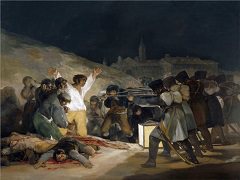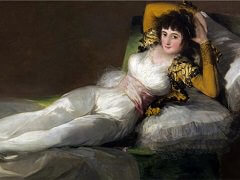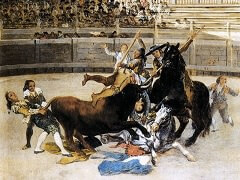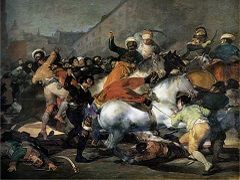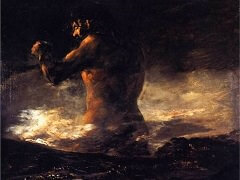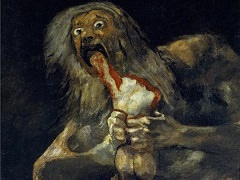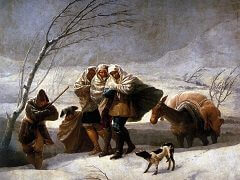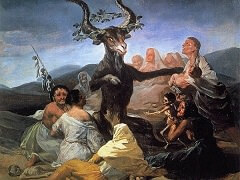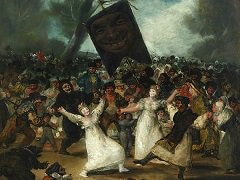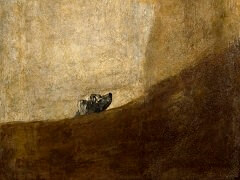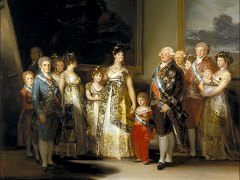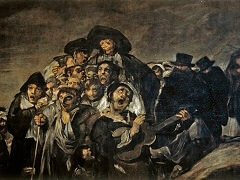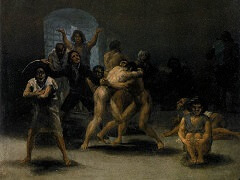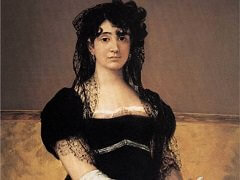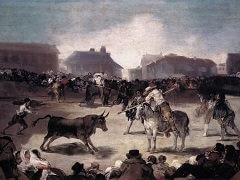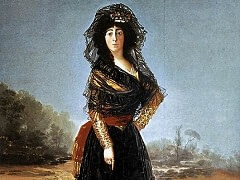Francisco Goya Biography

Goya was born in Fuendetodos, Aragón, Spain, in 1746 to José Benito de Goya y Franque and Gracia de Lucientes y Salvador. He spent his childhood in Fuendetodos, where his family lived in a house bearing the family crest of his mother. His father earned his living as a gilder. About 1749, the family bought a house in the city of Zaragoza and some years later moved into it. Goya may have attended school at Escuelas Pias. He formed a close friendship with Martin Zapater at this time, and their correspondence from the 1770s to the 1790s is a valuable source for understanding Goya's early career at the court of Madrid. At age 14, Goya studied under the painter José Luzán. He moved to Madrid where he studied with Anton Raphael Mengs, a painter who was popular with Spanish royalty. He clashed with his master, and his examinations were unsatisfactory. Goya submitted entries for the Royal Academy of Fine Art in 1763 and 1766, but was denied entrance.
He then relocated to Rome, where in 1771 he won second prize in a painting competition organized by the City of Parma. Later that year, he returned to Zaragoza and painted parts of the cupolas of the Basilica of the Pillar (including Adoration of the Name of God), a cycle of frescoes in the monastic church of the Charterhouse of Aula Dei, and the frescoes of the Sobradiel Palace. He studied with Francisco Bayeu y Subías and his painting began to show signs of the delicate tonalities for which he became famous.
Goya married Bayeu's sister Josefa (he nicknamed her "Pepa") on 25 July 1773. This marriage, and Francisco Bayeu's membership of the Royal Academy of Fine Art (from the year 1765) helped Goya to procure work as a painter of designs to be woven by the Royal Tapestry Factory. There, over the course of five years, he designed some 42 patterns, many of which were used to decorate (and insulate) the bare stone walls of El Escorial and the Palacio Real del Pardo, the newly built residences of the Spanish monarchs near Madrid. This brought his artistic talents to the attention of the Spanish monarchs who later would give him access to the royal court. He also painted a canvas for the altar of the Church of San Francisco El Grande in Madrid, which led to his appointment as a member of the Royal Academy of Fine Art.
In 1783, the Count of Floridablanca, a favourite of King Carlos III, commissioned Goya to paint his portrait. He also became friends with Crown Prince Don Luis, and spent two summers with him, painting portraits of both the Infante and his family. During the 1780s, his circle of patrons grew to include the Duke and Duchess of Osuna, whom he painted, the King and other notable people of the kingdom. In 1786, Goya was given a salaried position as painter to Charles III. After the death of Charles III in 1788 and revolution in France in 1789, during the reign of Charles IV, Goya reached his peak of popularity with royalty.
In 1789 he was made court painter to Charles IV and in 1799 he was appointed First Court Painter with a salary of 50,000 reales and 500 ducats for a coach. He painted the King and the Queen, royal family pictures, portraits of the Prince of the Peace and many other nobles. His portraits are notable for their disinclination to flatter, and in the case of Charles IV of Spain and His Family, the lack of visual diplomacy is remarkable. Modern interpreters have seen this portrait as satire; it is thought to reveal the corruption present under Charles IV. Under his reign his wife Louisa was thought to have had the real power, which is why she is placed at the center of the group portrait. From the back left of the painting you can see the artist himself looking out at the viewer, and the painting behind the family depicts Lot and his daughters, thus once again echoing the underlying message of corruption and gat.
Goya received orders from many within the Spanish nobility. Among those from whom he procured portrait commissions were Pedro Téllez-Girón, 9th Duke of Osuna and his wife María Josefa Pimentel, 12th Countess-Duchess of Benavente, María del Pilar de Silva, 13th Duchess of Alba (universally known simply as the "Duchess of Alba"), and her husband José María Álvarez de Toledo, 15th Duke of Medina Sidonia, and María Ana de Pontejos y Sandoval, Marchioness of Pontejos.
At some time between late 1792 and early 1793, a serious illness (the exact nature of which is not known), left Goya deaf, and he became withdrawn and introspective. During his recuperation, he undertook a series of experimental paintings. His experimental art which would encompass paintings, drawings as well as a bitter series of aquatinted etchings, published in 1799 under the title Caprichos was done in parallel to his more official commissions of portraits and religious paintings. In 1798 he painted luminous and airy scenes for the pendentives and cupula of the Real Ermita (Chapel) of San Antonio de la Florida in Madrid. Many place miracles of Saint Anthony of Padua in the midst of contemporary Madrid.
Later years
French forces invaded Spain in 1808, leading to the Peninsular War of 1808-1814. Goya's involvement with the court of the "Intruder king", Joseph I, the brother of Napoleon Bonaparte, is not known; he did paint works for French patrons and sympathisers, but kept neutral during the fighting. After the restoration of the Spanish king, Ferdinand VII, in 1814, Goya denied any involvement with the French. When his wife Josefa died in 1812, he was mentally and emotionally processing the war by painting The Charge of the Mamelukes and The Third of May 1808, and preparing the series of prints later known as The Disasters of War (Los desastres de la guerra). Ferdinand VII returned to Spain in 1814 but relations with Goya were not cordial. He painted portraits of the kings for a variety of organizations, but not for the king himself.
Leocadia Weiss (née Zorrilla, b. 1790) the artist's maid, younger by 35 years, and a distant relative, lived with and cared for Goya after Bayeu's death. She stayed with him in his Quinta del Sordo villa until 1824 with her daughter Rosario. Leocadia was probably similar in features to Goya's first wife Josefa Bayeu, to the extent that one of his well known portraits bears the cautious title of Josefa Bayeu (or Leocadia Weiss).
Not much is known about her beyond her fiery temperament. She was likely related to the Goicoechea family, a wealthy dynasty into which the artist's son, the feckless Javier, had married. It is believed she held liberal political views and was unafraid of expressing them, a fact met with disapproval by Goya's family. It is known that Leocadia had an unhappy marriage with a jeweler, Isideo Weiss, but was separated from him since 1811. Her husband cited "illicit conduct" during the divorce proceedings. She had two children before the marriage dissolved, and bore a third, Rosario, in 1814 when she was 26. Isideo was not the father, and it has often been speculatedalthough with little firm evidencethat the child belonged to Goya. There has been much speculation that Goya and Weiss were romantically linked, however, it is more likely the affection between them was sentimental.
Goya's works from 1814 to 1819 are mostly commissioned portraits, but also include the altarpiece of Santa Justa and Santa Rufina for the Cathedral of Seville, the print series of La Tauromaquia depicting scenes from bullfighting, and probably the etchings of Los Disparates.
In 1819, with the idea of isolating himself, he bought a country house by the Manzanares river just outside of Madrid. It was known as the Quinta del Sordo (roughly, "House of the Deaf Man", titled after its previous owner and not after Goya himself). There he created the Black Paintings with intense, haunting themes, reflective of the artist's fear of insanity, and his outlook on humanity. Several of these, including Saturn Devouring His Son, were painted directly onto the walls of his dining and sitting rooms.
Goya lost faith in or became threatened by the restored Spanish monarchy's anti-liberal political and social stance and left Spain in May 1824 for Bordeaux and then Paris. He travelled to Spain in 1826, but returned to Bordeaux, where he died of a stroke in 1828, at the age of 82. He was of Catholic faith and was buried in Bordeaux; in 1919 his remains were transferred to the Royal Chapel of St. Anthony of La Florida in Madrid.

